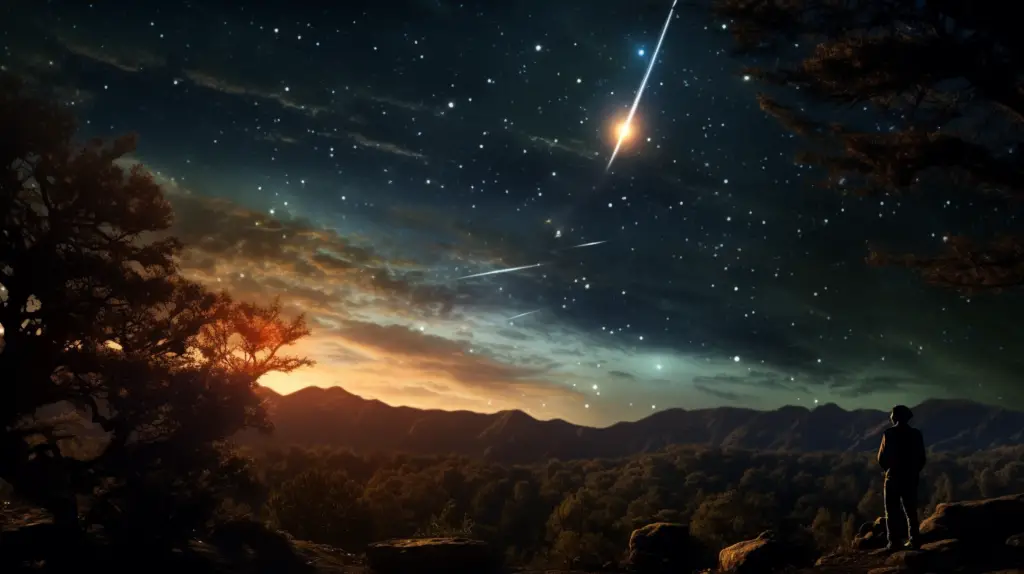Meteor showers have always inspired wonder and fascination. These celestial events are not only breathtaking but also serve as a reminder of the vastness and mystery of our universe. As sparks fly across the night sky, there is a lot more happening than meets the eye.
Dive with us into the realm of meteor showers as we unravel 25 captivating facts and delve into the science behind these mesmerizing displays.
- Cosmic Specks: Meteor showers occur when Earth passes through the debris left behind by a comet. These debris particles, mostly the size of a grain of sand, burn up in Earth’s atmosphere, causing the streaks of light we see.
- Not Shooting Stars: Despite the popular name “shooting stars,” meteors are not stars at all. They are tiny fragments from comets or, occasionally, from asteroids.
- Fast and Fiery: Meteors can enter the Earth’s atmosphere at speeds ranging from 25,000 to 160,000 miles per hour!
- Meteor, Meteoroid, Meteorite: Before entering our atmosphere, these celestial specks are known as meteoroids. When they burn up upon entering, they are meteors. If they survive the plunge and land on Earth, they are termed meteorites.
- Origin Stories: Every meteor shower can be traced back to a parent comet. For example, the famous Perseid meteor shower is linked to Comet Swift-Tuttle.
- Peak Time: The peak of a meteor shower is when the maximum number of meteors can be seen per hour. Some showers have a sharp peak, while others have a more extended plateau.
- Frequency: There are about 30 meteor showers annually that are visible to observers on Earth. Some are faint, while others can be quite spectacular.
- Eons Old: The particles causing meteor showers are ancient, often dating back several billion years to the early solar system.
- Long History: Ancient civilizations, from the Greeks to the Chinese, have records of observing meteor showers and have associated various myths with them.
- Radiant Point: Every meteor shower has a radiant point, the point in the sky from which meteors seem to emerge. This point is why meteor showers are named, typically after the constellation where the radiant lies.
READ MORE: 25 Interesting Facts About Berkshire Botanical Garden - All Shapes and Sizes: Meteoroids range in size from dust grains to boulders. The larger the meteoroid, the brighter the meteor.
- Short-lived Beauty: Most meteors are so small that they completely burn up in the atmosphere, never reaching the Earth’s surface.
- Not Just Night: Some meteor showers can be observed just before dawn or after sunset.
- Moon Matters: A full moon or a bright moon can make it hard to see meteors, as its brightness can outshine the fainter meteors.
- Spacedust: About 40,000 tons of cosmic dust falls on Earth every year, much of it from meteor showers.
- Oldest Meteor Shower: The Quadrantids, peaking in early January, are considered to be the oldest meteor shower, formed about 500 years ago.
- Meteor Showers on Other Planets: Mars, Venus, and other planets also experience meteor showers, just like Earth.
- Leonids and Storms: The Leonid meteor shower, peaking in November, has been known to become a meteor storm, producing thousands of meteors per hour.
- Meteoric Impact: Large meteorites have significantly impacted Earth’s history. The meteorite believed to cause the extinction of dinosaurs created the Chicxulub crater in Mexico.
- Rare Metals: Some meteorites can contain rare metals like iridium and gold.
READ MORE: 25 Interesting Facts About Thunderstorms and Why They Happen - Glowing Trails: The glowing trails of meteors, called ionized gas trails, can persist for a few seconds to minutes.
- Sounds Too?: Some observers claim to hear faint sounds associated with bright meteors, a phenomenon called “electrophonic meteors.”
- Predictable Patterns: Meteor showers occur around the same time each year, thanks to Earth’s consistent orbit around the sun and the stationary trails of comet debris.
- Meteor Showers & Culture: Many cultures have associated meteor showers with omens, prophecies, or messages from the gods.
- Research and Meteorites: Meteorites that land on Earth are valuable for scientific research, offering insights into the early solar system and beyond.
READ MORE: 25 Interesting Facts About Hibakujumoku, the Japanese Birch Tree
Meteor showers serve as a gateway to understanding our universe better. Every streak of light tells a story of ancient cosmic events and the ever-evolving dance of celestial bodies. So, the next time you gaze up at a meteor-studded sky, remember the vast history and science that come with each shimmering trail.


